KTM 85 SX, XC, XC 105 SX User Manual
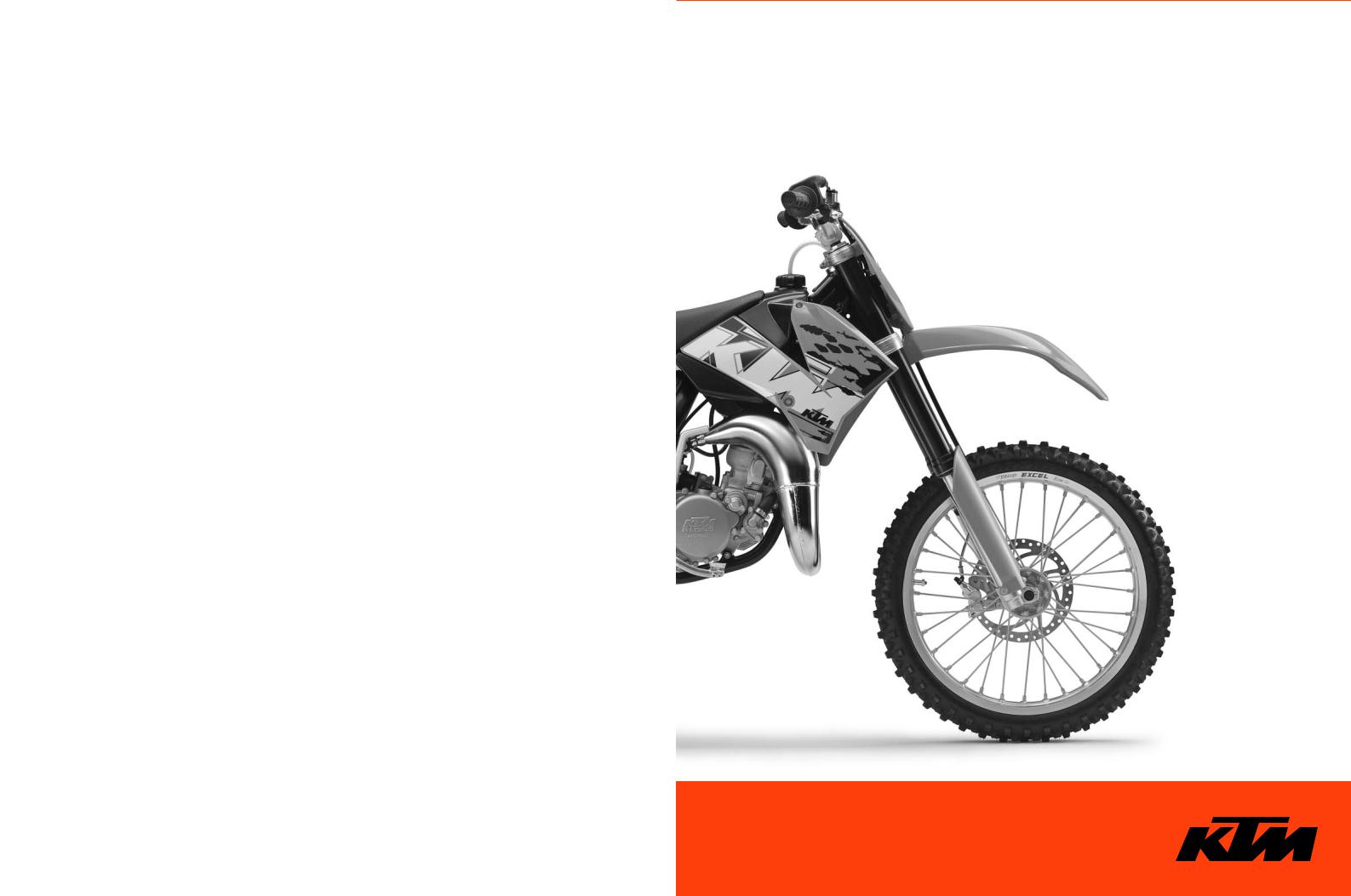
OWNER’S MANUAL 2008
85 SX, XC
105 SX, XC
3211224en
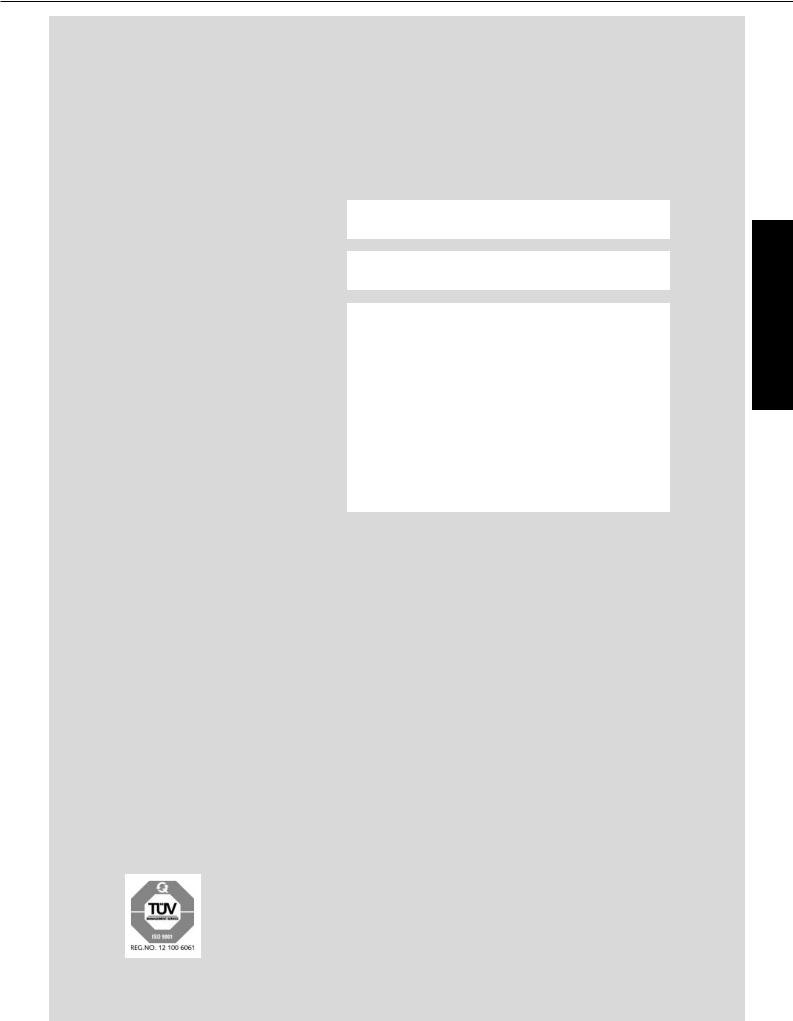
INTRODUCTION »
Now you own a modern motorcycle that you and your youngster will certainly enjoy, provided that you service and maintain it properly.
Please insert the serial numbers of the motorcycle below
Chassis number
Engine number
Stamp of dealer
All information contained is without obligation. KTM-Sportmotorcycle AG particularly reserves the right to modify any equipment, technical specifications, prices, colors, shapes, materials, services, service work, constructions, equipment and the like so as to adapt them to local conditions or to cancel any of the above items, all without previous announcement and without giving reasons. KTM may stop manufacturing certain models without previous notice. KTM shall not be held liable for any deviations of availability and/or ability to deliver, illustrations, descriptions, printing and/or other errors. The illustrated models partly contain extra equipment, which is not applied to standard models.
© 2007 by KTM-SPORTMOTORCYCLE AG, Mattighofen AUSTRIA; All rights reserved; Reprint, also in extracts, with written allowance of KTM-SPORTMOTORCYCLE AG, Mattighofen only.
ENGLISH
1
In accordance with the international quality management ISO 9001 standard, KTM uses quality assurance processes that lead to the highest possible product quality.
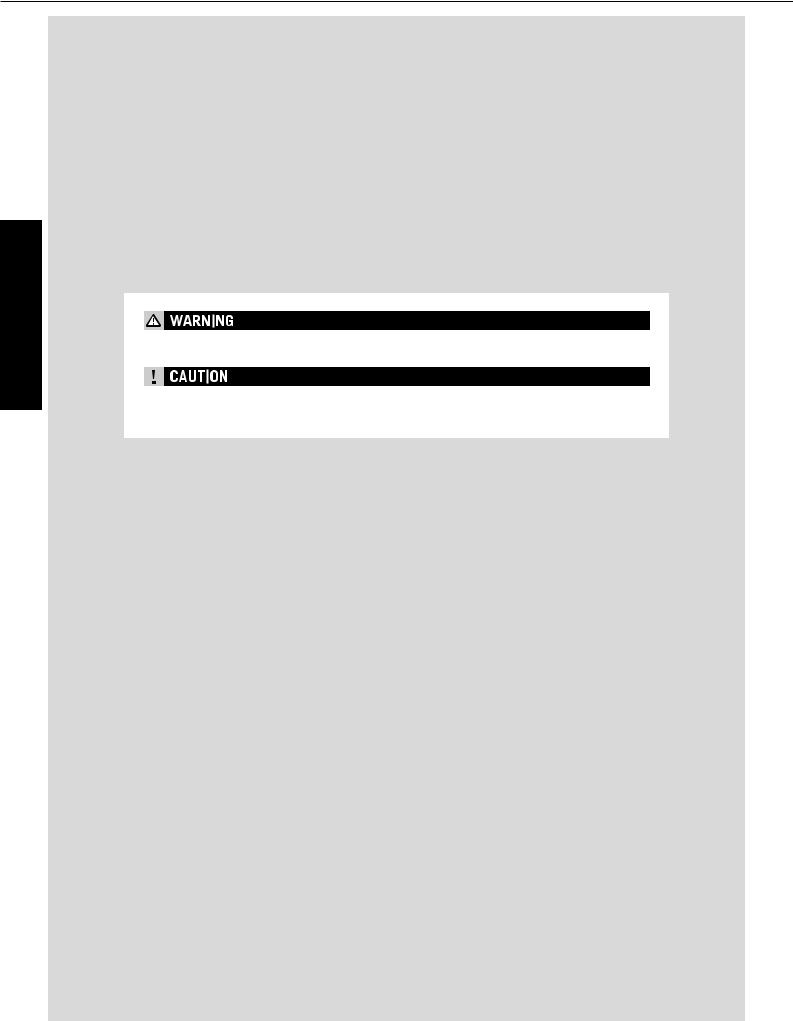
IMPORTANT INFORMATION »
ENGLISH
2
INTENDED PURPOSE
KTM mini-sports motorcycles are designed and constructed to resist the usual wear and tear of normal use in competitions.
The motorcycles comply with the regulations and categories currently in effect with the leading international motorcycle associations.
OWNER’S MANUAL
Please read this manual thoroughly before letting your youngster ride the motorcycle for the first time. This manual contains important information and recommendations that will help you and your youngster to operate and handle the motorcycle properly. In the interest of everybody involved, we urge you to pay particular attention to instructions and information marked as follows:
–Ignoring these instructions can be dangerous to life and limb!
–Ignoring these instructions may damage parts of the motorcycle or impair the motorcycle's traffic safety!
This manual contains important information on the operation and maintenance of your new KTM motorcycle. It went to press describing your model’s latest state of development. Nevertheless, the descriptions may deviate slightly from the current design as our motorcycles are permanently improved.The Owner's Manual is an integral part of the motorcycle and must be handed over to the new owner when the motorcycle is sold.
SERVICE
Observance of the service, maintenance and tuning instructions for the engine and chassis specified in the Owner's Manual is a prerequisite for faultless operation and the avoidance of premature wear. An improperly tuned chassis can lead to damage and breakage of the chassis components (see chapter on checking the basic chassis setting).
The use of the motorcycle under extreme conditions, e.g. on extremely muddy and wet terrain, can lead to higher than average wear on components such as the drive train or the brakes. In this case it may become necessary to service or replace wear parts before the service limit specified in the maintenance schedule has been reached.
We expressly point out that work marked with an asterisk (*) in the chapter "Maintenance work on the chassis and engine" must be performed by a KTM workshop. If maintenance work should become necessary during a competition, it must be performed by a trained mechanic.
Please strictly observe the prescribed running-in periods and inspection and maintenance intervals. Compliance with these instructions will significantly prolong the life of your motorcycle.

IMPORTANT INFORMATION »
WARRANTY
The service work specified in the "Lubrication and Maintenance Schedule" must be performed by a KTM workshop and recorded in the service manual otherwise claims under the warranty shall become void. No claims can be filed under the warranty for damage or consequential damage caused by manipulations or conversions to the motorcycle.
AUTOMOTIVE FLUIDS
The fuels and lubricants specified in the Owner's Manual or automotive fluids with equivalent specifications must be used in accordance with the maintenance schedule.
SPARE PARTS, ACCESSORIES
For the safety of your child, only use spare parts and accessories approved by KTM. KTM shall not assume any liability for other products or consequential damage resulting from the use of such products.
When special needs arise, please contact a KTM dealer, who will seek the assistance of the KTM importer if necessary.
SAFETY
Parents should keep in mind that the safety of their youngsters always depends on the efforts made by the parents to ensure that the motorcycle is kept in good working order and only used on safe terrains. Nevertheless, driving the motorcycle, like driving any other vehicle, involves a potential risk. Therefore, please make sure that all fundamental precautions are taken. Please also read the „INFORMATION ON SAFE DRIVING FOR PARENTS“ on page 4.
TRANSPORT
When transporting your motorcycle, secure it with elastic straps or other mechanical devices in an upright position. Be sure that the fuel tap is closed. If the motorcycle topples over, fuel can flow out of the carburetor or fuel tank.
ENVIRONMENT
Riding an off-highway motorcycle is a wonderful form of outdoor recreation and we certainly hope that you and your youngsters will enjoy it to the full. However, this enjoyable outdoor activity can cause environmental problems or lead to conflicts with other people. Responsible use of the motorcycle will prevent such problems and conflicts. You can contribute to securing the future of motorcycling by making sure that you and your youngsters only use the motorcycle within the limits established by the applicable laws, making environmental protection one of your top priorities and never violating other people’s rights.
In this spirit, we hope that you and your youngsters will always safely enjoy your motorcycle!
KTM-SPORTMOTORCYCLE AG 5230 MATTIGHOFEN, AUSTRIA
ENGLISH
3
Attachments: 1 spare parts manual chassis & engine
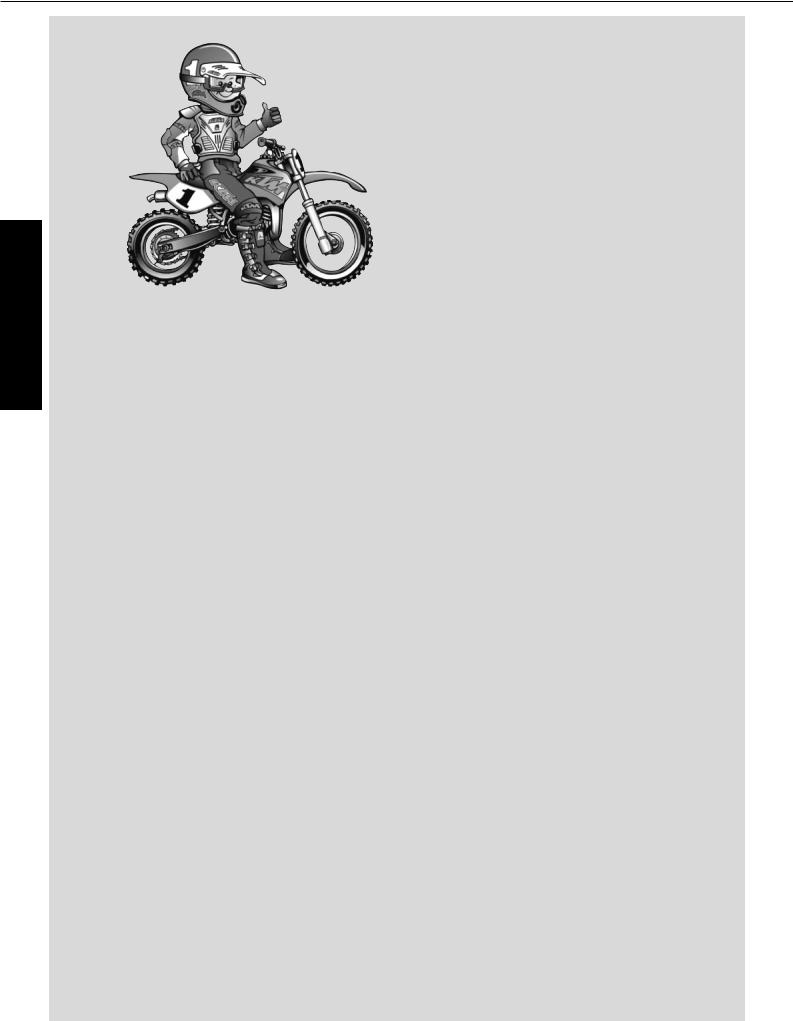
IMPORTANT INFORMATION FOR PARENTS ABOUT SAFE DRIVING »
ENGLISH
4
The 85/105 SX/XC mini motorcycles are off-road motorcycles designed for one person only. They are not allowed on public roads.
The vehicle dimensions and components are designed for children from 10 to 15 years of age with a maximum weight of 75 kg (33,98 lb).
–Have your youngster wear proper protective gear whenever he or she rides the motorcycle: helmet, eye protection, chest, back, arm and leg protectors, gloves and boots. To set a good example, be sure to wear protective gear yourself whenever riding a motorcycle!
–Before your youngster takes his or her first ride, explain how each of the controls works and check if your youngster has understood what you explained. We recommend to review the entire owner’s manual with your youngster item by item, paying particular attention to the specially marked warnings and pointing out the danger of injury.
–Instruct your youngster about riding and falling techniques, explain how the motorcycle will respond to shifting of the rider’s weight, etc.
–Before starting the motorcycle for the first time check whether the basic fork and shock absorber settings are suitable for your child's weight (see chapter on checking the basic chassis setting)
–Before using the motorcycle you should always check all components for proper operation (see mainenance schedule). Have your youngster perform these technical checks himself / herself as well.
–Whenever you go for a ride with your youngster, keep in mind that the speed should be adjusted to your youngster and not the other way around.
–Your youngster must understand that all instructions he or she receives from you or any other supervising adult must be followed.
–Your child must be physically ready to ride a motorcycle. This means that he or she must at least be able to ride a bicycle. Being good at sports that require fast reactions is an additional advantage. Your youngster should be strong enough to pick up the motorcycle after a fall.
–Never demand too much of your youngster. Give him or her time to get used to the motorcycle and to improve his / her riding skills. Do not even consider letting your youngster participate in a race before his / her physical condition, riding skills and motivation have sufficiently developed.
–Explain to your youngster that he / she should always adjust his / her riding speed to the local conditions as well as to his / her own riding skills and that excessive speed can cause falls and severe injuries. Always keep in mind that youngsters tend to underestimate dangers or fail to recognize them altogether. The riding speed must be reduced, in particular, on unknown terrain.
–Never let your youngster ride the motorcycle without supervision. An adult should always be present.
–The motorcycle is designed for one rider only. Your youngster is not allowed to transport a passenger.
–When you go for a ride, somebody at home should always know where you are going and when you will be back. This makes it easier to send you help, should problems occur.

TABLE OF CONTENTS »
Page IMPORTANT INFORMATION FOR PARENTS ABOUT SAFE DRIVING . . . . . . . . . . . . . . . . . . . . . . . . . . . . . . . . . . .4
SERIAL NUMBER LOCATIONS . . . . . . . . . . . . . . . . . . . .6 Chassis number . . . . . . . . . . . . . . . . . . . . . . . . . . . .6 Engine number . . . . . . . . . . . . . . . . . . . . . . . . . . . . .6
OPERATION INSTRUMENTS . . . . . . . . . . . . . . . . . |
. . . .6 |
Clutch lever . . . . . . . . . . . . . . . . . . . . . . . . . . . |
. . . .6 |
Hand brake lever . . . . . . . . . . . . . . . . . . . . . . . . . |
. . .6 |
Short circuit button . . . . . . . . . . . . . . . . . . . . . . . |
. . .7 |
Filler cap . . . . . . . . . . . . . . . . . . . . . . . . . . . . . . |
. . .7 |
Fuel tap . . . . . . . . . . . . . . . . . . . . . . . . . . . . . . . |
. . .7 |
Choke . . . . . . . . . . . . . . . . . . . . . . . . . . . . . . . . |
. . .7 |
Shift lever . . . . . . . . . . . . . . . . . . . . . . . . . . . . . |
. . .7 |
Kickstarter . . . . . . . . . . . . . . . . . . . . . . . . . . . . . |
. . .8 |
Foot brake pedal . . . . . . . . . . . . . . . . . . . . . . . . . |
. . .8 |
PluginStand . . . . . . . . . . . . . . . . . . . . . . . . . . . |
. . .8 |
Side stand . . . . . . . . . . . . . . . . . . . . . . . . . . . . . |
. . .8 |
Compression damping of fork . . . . . . . . . . . . . . . . |
. . .8 |
Rebound damping of fork . . . . . . . . . . . . . . . . . . . |
. . .8 |
Damping action during compression of shock absorber .9 |
|
Rebound damping function of the shock absorber |
. . . .9 |
GENERAL TIPS AND WARNINGS FOR STARTING THE MOTORCYCLE . . . . . . . . . . . . . . . . . . . . . . . . . . . . . .10
Instructions for the first ride . . . . . . . . . . . . . . . . . . .10 Running in . . . . . . . . . . . . . . . . . . . . . . . . . . . . . . .10
DRIVING INSTRUCTIONS . . . . . . . . . . . . . . . . . . . . . .11 What you should check before each start . . . . . . . . . .11 Starting when the engine is cold . . . . . . . . . . . . . . . .12 Starting when the engine is warm . . . . . . . . . . . . . . .12 What to do when the engine is “flooded“ . . . . . . . . . .12 Starting off . . . . . . . . . . . . . . . . . . . . . . . . . . . . . . .12 Shifting/Riding . . . . . . . . . . . . . . . . . . . . . . . . . . . .12 Refueling, fuel . . . . . . . . . . . . . . . . . . . . . . . . . . . .13 Braking . . . . . . . . . . . . . . . . . . . . . . . . . . . . . . . . .13 Stopping . . . . . . . . . . . . . . . . . . . . . . . . . . . . . . . .13
PERIODIC MAINTENANCE SCHEDULE . . . . . . . . . . . . .14
MAINTENANCE WORK ON CHASSIS AND ENGINE . . . .16 Checking and adjusting the steering head bearing . . .16 Breather plug front fork . . . . . . . . . . . . . . . . . . . . . .16 Cleaning the dust sleeves of the telescopic fork . . . . .17 How to change the handlebar position . . . . . . . . . . . .17 Changing the spring preloading of the shock absorber .17 Basic suspension setup for the weight of the driver . . .18 Checking the shock absorber and spring . . . . . . . . . .18
Page Determining the static sag of the shock absorber . . . .18 Determining the riding sag of the shock absorber . . . .18 Overview of the shock absorber springs . . . . . . . . . . .19 Checking the basic setup of the telescopic fork . . . . .19 Overview of the telescopic fork springs . . . . . . . . . . .19 Checking chain tension . . . . . . . . . . . . . . . . . . . . . .20 Correct chain tension . . . . . . . . . . . . . . . . . . . . . . . .20 Chain maintenance . . . . . . . . . . . . . . . . . . . . . . . . .20 General information about KTM disc brakes . . . . . . . .21 Adjusting free travel of the hand brake lever . . . . . . .21 Checking the brake fluid level/ refilling . . . . . . . . . . .22 Checking front brake pads . . . . . . . . . . . . . . . . . . . .22 Replacing the front brake pads . . . . . . . . . . . . . . . . .22 Changing basic position of the brake pedal . . . . . . . .23 Checking the rear brake fluid level . . . . . . . . . . . . . .23 Refilling the rear brake fluid reservoir . . . . . . . . . . . .23 Checking rear brake pads . . . . . . . . . . . . . . . . . . . . .23 Dismounting and mounting the front wheel . . . . . . . .24 Dismounting and mounting the rear wheel . . . . . . . . .25 Tires, air pressure . . . . . . . . . . . . . . . . . . . . . . . . . .25 Checking spoke tension . . . . . . . . . . . . . . . . . . . . . .25 Cleaning the air filter . . . . . . . . . . . . . . . . . . . . . . . .26 Exhaust system . . . . . . . . . . . . . . . . . . . . . . . . . . . .26 Changing the original position of the clutch lever . . . .27 Checking the oil level of the hydraulic clutch . . . . . . .27 Bleeding of the hydraulic clutch . . . . . . . . . . . . . . . .27 Adjusting the throttle cable . . . . . . . . . . . . . . . . . . .27 Cooling system . . . . . . . . . . . . . . . . . . . . . . . . . . . .28 Checking coolant level . . . . . . . . . . . . . . . . . . . . . . .28 Refilling/Bleeding the cooling system . . . . . . . . . . . .28 Carburetor adjustment . . . . . . . . . . . . . . . . . . . . . . .29 Draining the float chamber of the carburetor . . . . . . .30 Checking gear oil level . . . . . . . . . . . . . . . . . . . . . . .30 Changing gear oil . . . . . . . . . . . . . . . . . . . . . . . . . .30
TROUBLE SHOOTING . . . . . . . . . . . . . . . . . . . . . . . . .31
CLEANING . . . . . . . . . . . . . . . . . . . . . . . . . . . . . . . . .33
STORAGE . . . . . . . . . . . . . . . . . . . . . . . . . . . . . . . . . .33 Use after period of storage . . . . . . . . . . . . . . . . . . . .33
TECHNICAL SPECIFICATIONS – CHASSIS . . . . . . . . . .34
TECHNICAL SPECIFICATIONS - ENGINE . . . . . . . . . . .35
CARBURETOR SETTING . . . . . . . . . . . . . . . . . . . . . . .37
HEAD WORD INDEX . . . . . . . . . . . . . . . . . . . . . . . . . .38
ENGLISH
5
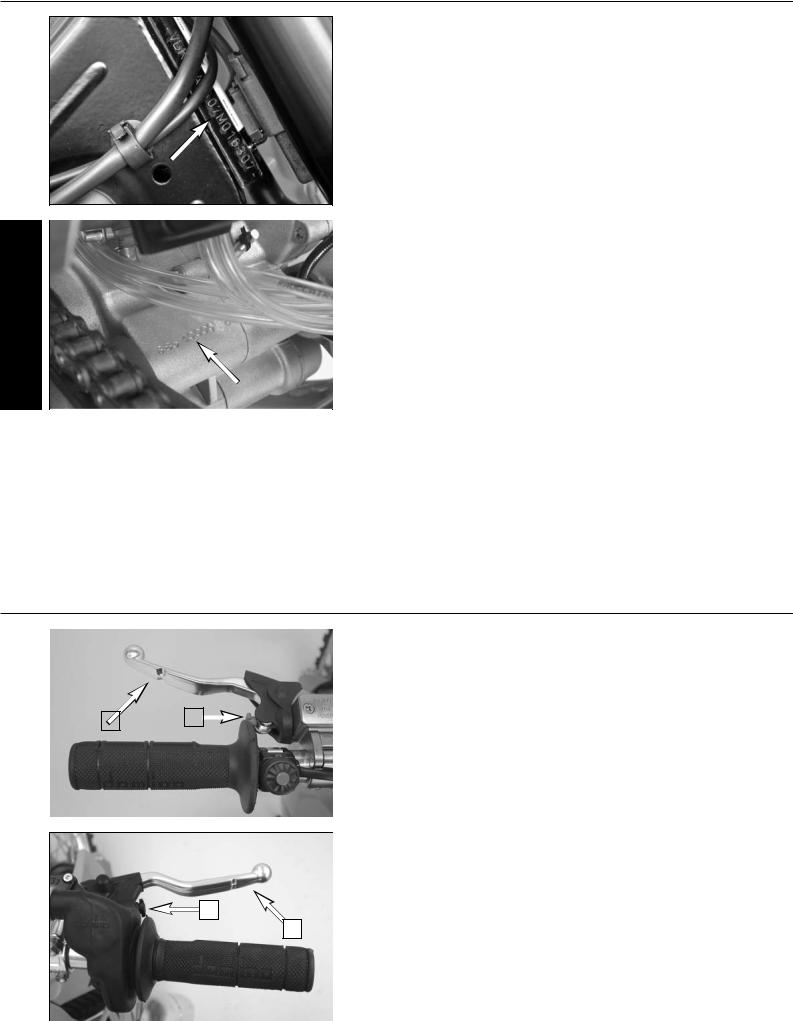
ENGLISH
6
SERIAL NUMBER LOCATIONS »
Chassis number
The chassis number is stamped on the right side of the steering head tube.
Enter this number in the field on page no 1.
Engine number
The engine number is stamped into the engine housing underneath the carburetor. Enter this number in the field on page no 1.
OPERATION INSTRUMENTS »
|
1 |
A |
|
|
|
||||
|
||||
|
|
|
|
|
|
|
|
|
|
B
2
Clutch lever
The clutch lever [1] is located on the left side of the handlebar. The adjusting screw [A] is used to change the original position of the clutch lever (see maintenance work on chassis and engine).
The clutch is hydraulically actuated and adjusts itself automatically.
Hand brake lever
The hand brake lever [2] is mounted on the handle bars on the right and actuates the front wheel brake.The adjusting screw [B] is used to change the original position of the hand brake lever (see maintenance work on chassis and engine).
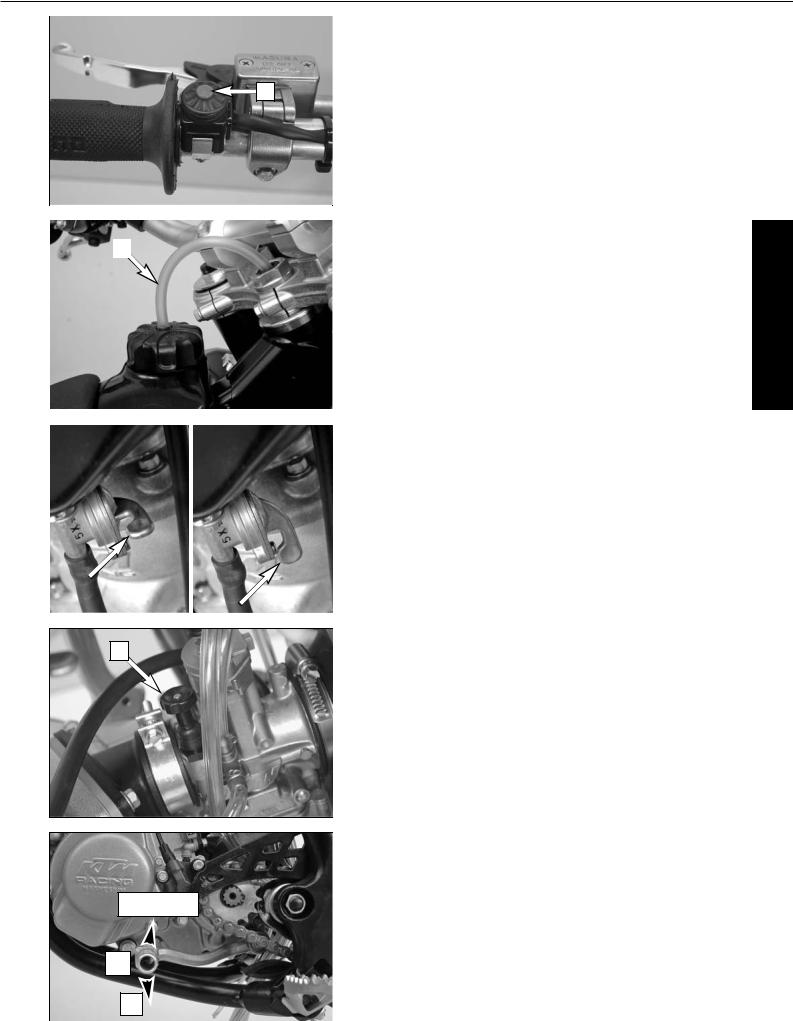
OPERATION INSTRUMENTS »
Short circuit button
The short circuit button [1] turns off the engine. When pressing this button, the ignition circuit is short-circuited.
1
|
|
|
Filler cap |
|
|
|
|
|
|
|
To open it: turn filler cap counter-clockwise. |
|
2 |
|
|
|
|
To close it: put filler cap back on and tighten it by turning it clockwise. |
|
|
|
|
|
|
|
|
Install tank breather hose [2] without kinks. |
|
|
|
|
OFF |
|
|
ON |
|
|
|
|
|
|
|
|
|
|
|
3
2,3,4,5,6
Fuel tap
OFF In this position the fuel tap is closed. No fuel can flow to the carburetor. ON When the motorcycle is running the grip is must be in the ON position to enable fuel to flow to the carburetor. The tank will
drain completely in this position.
Choke
The choke button [3] is located on the left side of the carburetor. Pulling the choke button [3] all the way out opens a bore in the carburetor through which the engine can take in additional fuel, thus achieving the "rich" fuel air mixture needed for cold starting.
Pushing the choke button back in closes the bore in the carburetor.
Shift lever
The shift lever is mounted on the left side of the engine. The position of the gears is shown in the illustration. Neutral, or the idle speed, is located between first and second gear.
N
ENGLISH
7
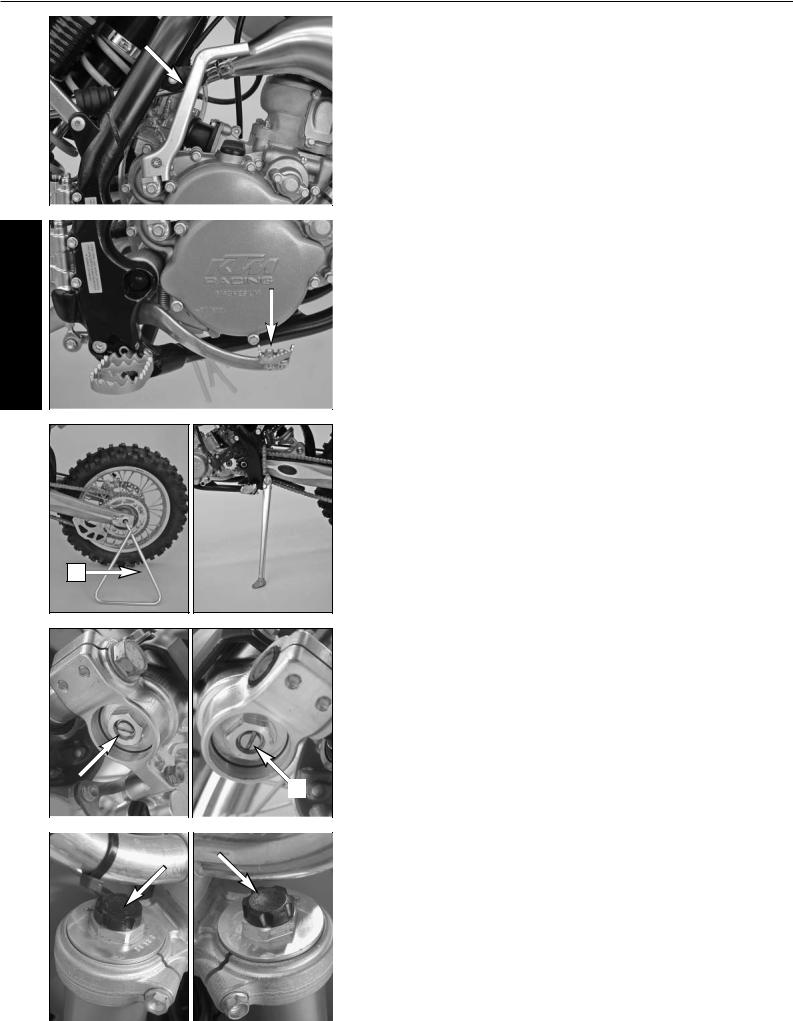
ENGLISH
8
OPERATION INSTRUMENTS »
Kickstarter
The kickstarter is mounted on the right side of the engine. Its upper part can be swivelled.
Foot brake pedal
The foot brake pedal is located in front of the right foot rest. Its basic position can be adjusted to your seat position (see maintenance work).
PluginStand (SX)
The plug-in stand [1] included in the scope of supply can be plugged into the left side of the bike at the end of the swinging fork.
Side Stand (XC):
Use your foot to swing the side stand forwards to the stop. Make sure it rests securely on solid ground.
1
Compression damping of fork
Hydraulic compression damping determines the reaction when the fork is compressed. The degree of compression can be adjusted with adjusting screws at the bottom of the fork legs.Remove the protecting cap.
Turn the knob [2] clockwise to increase damping, turn it counterclockwise to reduce damping during compression.
STANDARD ADJUSTMENT
–turn adjusting screw clockwise as far as it will go
–turn it back by as many clicks as are specified for the relevant type of fork
|
2 |
|
|
|
|
|
|
|
Type WP Suspension |
05187D05 |
15 clicks |
|
|
|
|
|
2 |
|
|||||
|
|
|
|
|
|
|
|
||||
|
|
|
|
|
|
|
|
|
Type WP Suspension |
05187D06 |
20 clicks |
|
|
|
|
|
|
|
|
|
|||
|
|
|
|
|
|
|
|
|
Rebound damping of fork |
|
|
|
|
|
|
|
|
|
|
|
|
||
|
|
|
|
|
|
|
|
|
|
||
|
|
|
|
|
3 |
|
|
|
Hydraulic rebound damping determines the reaction when the fork is |
||
|
|
|
3 |
|
|
||||||
|
|
|
|
|
|
|
|
rebound. By turning the adjusting screw [3] (REB), the degree of damping of |
|||
|
|
|
|
|
|
|
|
||||
|
|
|
|
|
|
|
|
|
the rebound can be adjusted. Turn the knob clockwise to increase damping, |
||
|
|
|
|
|
|
|
|
|
turn it counterclockwise to reduce damping during rebounding. |
||
STANDARD ADJUSTMENT
–turn adjusting screw clockwise as far as it will go
–turn it back by as many clicks as are specified for the relevant type of fork
Type WP Suspension |
05187D05 |
20 clicks |
Type WP Suspension |
05187D06 |
20 clicks |
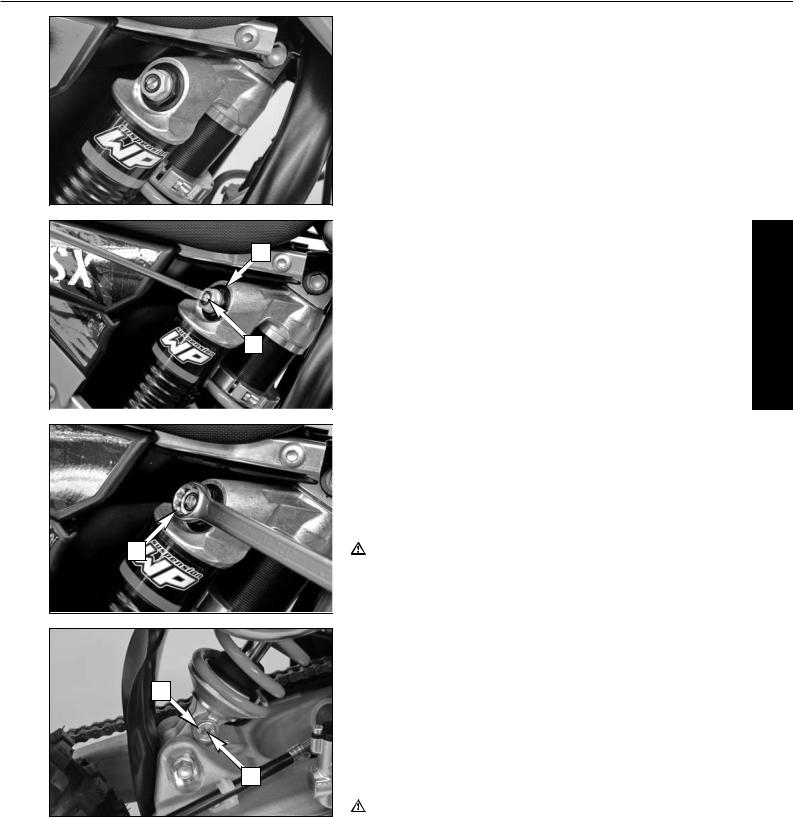
OPERATION INSTRUMENTS »
Damping action during compression of shock absorber
The shock absorber on the models can synchronize the compression damping in the low and high-speed range separately (Dual Compression Control).
Low and high speed refers to the movement of the shock absorber during compression and not to the speed of the motorcycle.
The low and high-speed technology overlaps.
The low-speed setting is primarily for slow to normal shock absorber compression rates.The high-speed setting is effective at fast compression rates.Turning in a clockwise direction will increase the damping, turning counterclockwise will decrease the damping.
3
1
2
5
4
Standard low-speed setting:
–Turn the adjusting screw [1] to the limit in a clockwise direction using a screwdriver .
–Unscrew the respective number of clicks for the specific type of shock absorber in a counterclockwise direction.
Type WP Suspension |
15187D02 |
15 clicks |
Type WP Suspension |
15187D04 |
15 clicks |
Standard high-speed setting:
–Turn the adjusting screw [2] to the limit in a clockwise direction using a box wrench.
–Unscrew the respective number of turns for the specific type of shock absorber in a counterclockwise direction.
Type WP Suspension 1518DC02 |
2 turns |
||
Type WP Suspension 15187D04 |
2 turns |
||
|
|
|
|
|
|
|
|
The damping unit of the shock absorber is filled with high-compression nitrogen. Never try to take the shock absorber apart or to do any maintenance work yourself. Severe injuries could be the result.
Never unscrew the black screw 3 connection (24mm).
Rebound damping function of the shock absorber
By using the adjusting screw [4], the degree of damping of the rebound can be adjusted. Turn the knob clockwise to increase damping, turn it counterclockwise to reduce damping during rebounding.
STANDARD ADJUSTMENT:
–turn the adjusting screw clockwise to the stop.
–then turn the adjusting screw counterclockwise, counting the number of clicks that corresponds to the respective type of shock absorber.
Type WP Suspension 15187D02 |
22 clicks |
||
Type WP Suspension 15187D04 |
22 clicks |
||
|
|
|
|
|
|
|
|
The damping unit of the shock absorber is filled with high-compression nitrogen. Never try to take the shock absorber apart or to do any maintenance work yourself. Severe injuries could be the result.
Never unscrew the black screw connection 5 (15mm).
ENGLISH
9
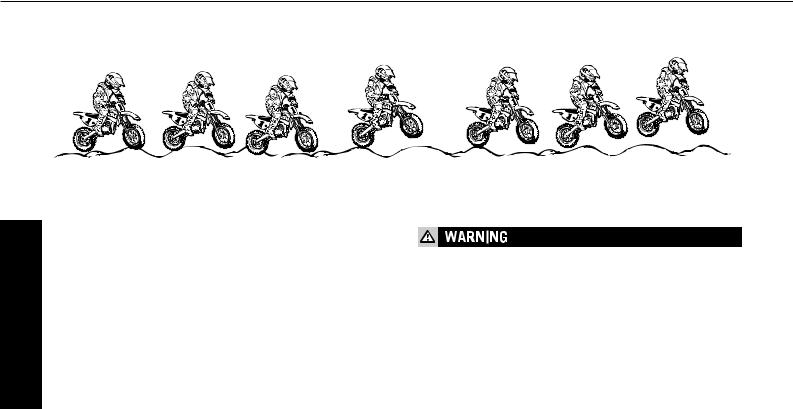
GENERAL TIPS AND WARNINGS FOR STARTING THE MOTORCYCLE »
ENGLISH
10
Instructions for the first ride
–Make sure the work for the "pre-delivery inspection" was performed by your authorized KTM workshop. The DELIVERY CERTIFICATE and SERVICE MANUAL will be handed over when you pick up your vehicle.
–Before your youngster takes his or her first ride, explain how each of the controls works and check if your youngster has understood what you explained. We recommend to review the entire owner’s manual with your youngster item by item, pay ing particular attention to the specially marked warnings and pointing out the danger of injury.
–Adjust the clutch lever, hand lever and foot brake pedal so your child can operate them easily!
–To prevent injury, teach your youngster the basic riding skills on soft ground, e.g. on a meadow or in the garden. Be sure that there is room enough to maneuver, and that no other rid ers are close.
–To ensure that your youngster gets the feel of the hand brake, have your youngster operate the hand brake while you push the motorcycle. Do not start the engine before your young ster has learned to apply hand brake with appropriate pressure.
–To familiarize your youngster with the operation of the hand brake let him or her practice to operate the hand brake while you are pushing the motorcycle. Do not start the engine before he or she is thoroughly familiar with the use of the hand brake.
–Initially, your youngster should ride back and forth between two persons who help the young rider to stop the motorcycle. However, you should also teach your youngster how to stop the motorcycle himself/herself.
–To improve his/her riding skills, your youngster should prac tise riding the motorcycle standing on the footpegs or to rid ing at the slowest possible speed. Additionally, you can arrange a series of obstacles and have your youngster drive around them, etc.
–Pay attention to the running-in procedure.
Running in
–Even very precisely machined sections of engine components have rougher surfaces than components which have been sli ing across one another for quite some time. Therefore, every engine needs to be broken in. For this reason, during its first 30 minutes the engine must not be revved up to its perform ance limits.
–Apply low but changing loads for running-in.
–DO NOT DRIVE AT FULL LOAD FOR THE FIRST 30 MINUTES!
–Have your youngster wear proper protective gear whenever he or she rides the motorcycle: helmet, eye protection, chest, back, arm and leg protectors, gloves and boots. To set a good example, be sure to wear protective gear yourself whenever riding a motorcycle!
–Only use accessory parts recommended by KTM.
–The front and rear wheel are only allowed to be tired with tires that have the same profile type.
–Your youngster's driving speed should always be adjusted to his/her driving skills as well as to the terrain.
–Your youngster should never be allowed to ride the motorcycle without supervision.
–Replace the helmet visor or goggle glasses early enough. When light shines directly on a scratched visor or goggles, you will be practically blind.
–Never leave your motorcycle without supervision as long as the engine is running.
–SX and XC models are designed for one person only. Passengers are not allowed.
–These models do not comply with the regulations and safety standards established by the law. Therefore, they are not permitted on public roads.
–Always keep in mind that other people feel molested by excessive noise.
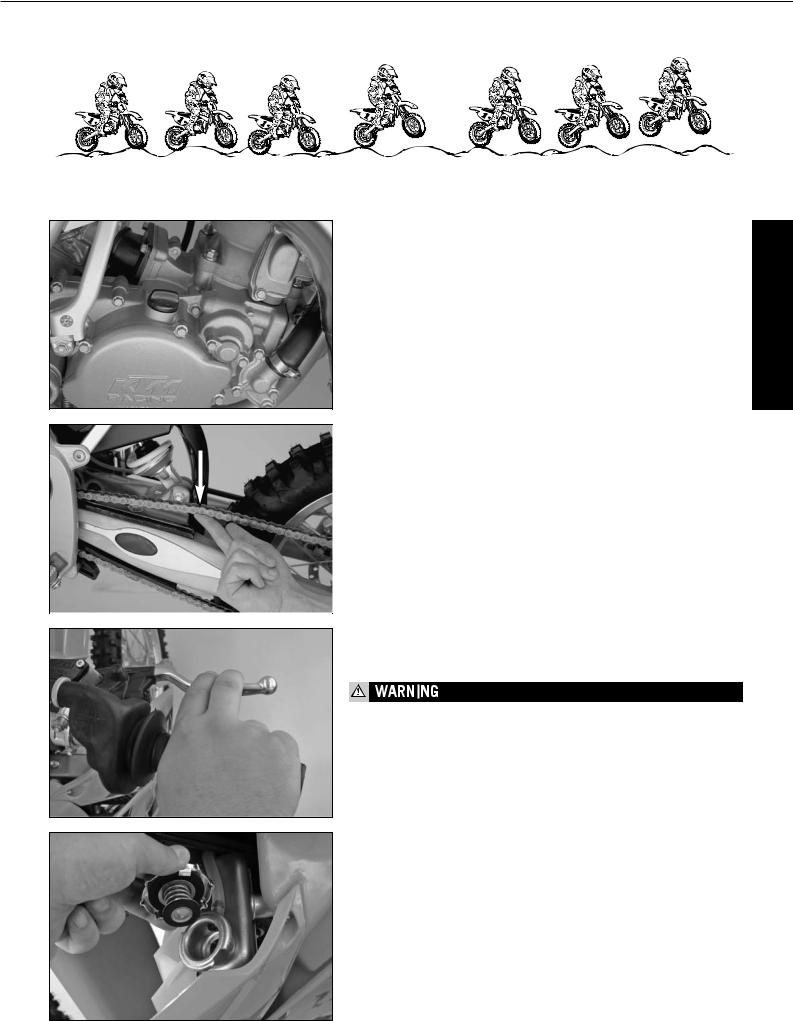
DRIVING INSTRUCTIONS »
What you should check before each start
When you start off, the motorcycle must be in a perfect technical condition. For safety reasons, you should make it a habit to perform an overall check of your motorcycle before each start.
The following checks should be performed:
1CHECKING THE ENGINE
Check the engine for any oil leakage. Too little gear oil will lead to premature wear and consequently destroy the transmission.
2FUEL
Check that there is sufficient fuel in the tank; when closing the filler cap, check that the tank venting hose is free of kinks.
3CHAIN
A loose chain was fall off the chain wheels; an extremely worn chain may tear, and insufficient lubrication may result in unnecessary wear of the chain and chain wheels.
4TIRES
Check for damaged tires. Tires showing cuts or dents must be replaced. Also check the air pressure. Insufficient tread and incorrect air pressure deteriorate the driving performance.
5BRAKES
Check the correct functioning of the braking system. Verify that there is sufficient brake fluid in the reservoir. The reservoirs have been designed in such a way that brake fluid does not need to be refilled even when the brake pads are worn. If the level of brake fluid falls below the minimum value, this indicates a leak in the braking system or completely worn out brake pads. Always have the brake system checked by a KTM workshop to avoid brake failure.
Also check the state of the brake hose and the thickness of the brake linings. Check free travel at the hand brake lever and foot brake lever.
If the resistance in the hand brake lever feels “spongy” (too much play), this is an indication that something is wrong with the brake system. Don’t let your child ride the motorcycle anymore without first having the brake system looked over by a KTM dealer.
6CABLES
Check correct setting and easy running of all control cables.
7COOLING FLUID
Check the level of cooling fluid when the engine is cold.
ENGLISH
11
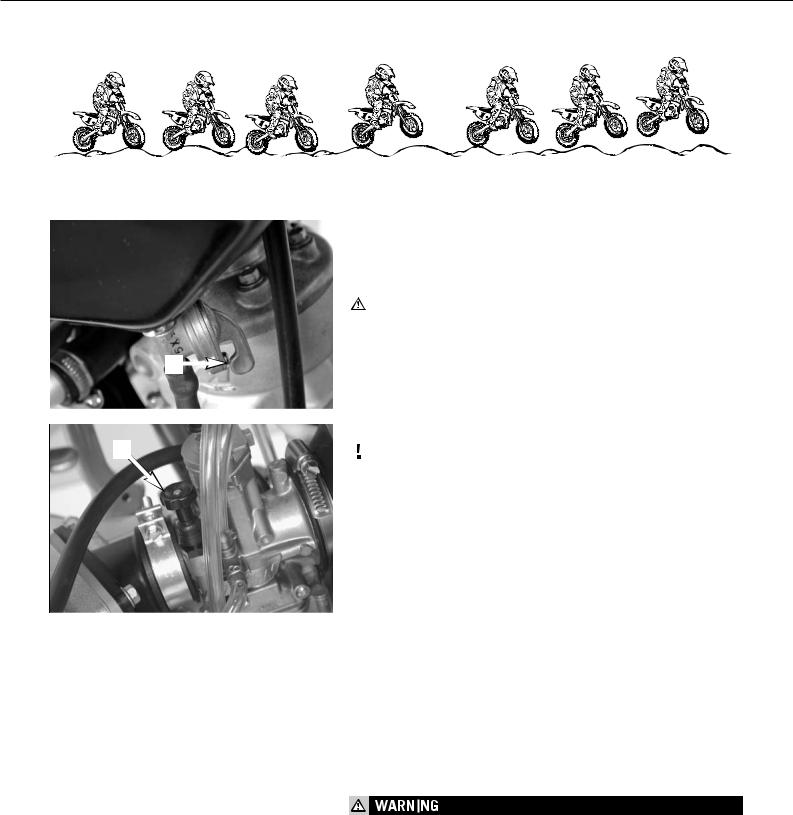
DRIVING INSTRUCTIONS »
|
|
|
|
|
|
|
|
Starting when the engine is cold |
||||
|
|
|
|
|
|
|
|
|||||
|
|
|
|
|
|
|
|
1 |
Open fuel tap [1] . |
|||
ENGLISH |
|
|
|
|
|
|
|
2 |
Put the gear in neutral |
|||
|
|
|
|
|
|
|
3 |
Activate the cold-starting aid (choke) [2]. |
||||
|
|
|
|
|
|
|
|
|||||
|
|
|
|
|
|
|
|
4 |
Leave throttle closed and kick down the kickstarter vigorously all the way. |
|||
|
|
|
|
|
|
|
|
|
|
|||
|
|
|
|
|
|
|
|
|
|
|
|
|
|
|
|
|
|
|
|
|
|
– To avoid injury when starting the engine, always wear strong bikers boots!You |
|||
|
|
|
|
|
|
|
|
|
|
may slip off the kickstarter, or the engine may kick back if you do not kick |
||
|
|
|
|
|
|
|
|
|
|
hart enough. |
||
|
|
|
1 |
|
|
|
– |
Check for power transmission at temperatures below 0°C (32°F) before |
||||
|
|
|
|
|
||||||||
|
|
|
|
|
||||||||
|
|
|
|
|
|
|
|
|
|
you actuate the kickstarter. If you depress the kickstarter without feeling |
||
|
|
|
|
|
|
|
|
|
|
|||
12 |
|
|
|
|
|
|
|
|
|
any resistance, power ist not being transmitted. This could cause injuries. |
||
|
|
|
|
|
|
|
|
|
– Do not start the engine and allow it to idle in a closed area. Exhaust fumes |
|||
|
|
|
|
|
|
|
|
|
|
are poisonous and can cause loss of consciousness and death. Always pro- |
||
|
|
|
|
|
|
|
|
|
|
vide adequate ventilation while the engine is running. |
||
|
|
|
|
|
|
|
|
|
|
|
|
|
|
|
2 |
|
|
|
|
|
|
|
|
|
|
|
|
|
|
|
|
|
|
Do not ride your motorcycle at full load and do not rev up the engine when |
||||
|
|
|
|
|
|
|
|
cold. since the piston warms up and expands faster than the water cooled |
||||
|
|
|
|
|
|
|
|
cylinder, this might cause engine damage. always let engine idle until warm |
||||
|
|
|
|
|
|
|
|
or drive it warm at low r.p.m. speeds. |
||||
|
|
|
|
|
|
|
|
NOTE: |
||||
|
|
|
|
|
|
|
|
The highly inflammable components in modern fuels volatilize if left stand- |
||||
|
|
|
|
|
|
|
|
ing for longer periods of time. If the motorcycle has not been used for over |
||||
|
|
|
|
|
|
|
|
1 week, the fuel should be drained from the float chamber. The engine will |
||||
|
|
|
|
|
|
|
|
start up immediately if the float chamber is filled with fresh, ignitable fuel |
||||
Starting when the engine is warm
1Open fuel tap
2Put the gear in neutral
3Leave throttle closed and kick down kickstarter vigorously all the way.
What to do when the engine is “flooded“
1Close fuel tap
2Start engine with full throttle. If necessary, unscrew spark plug and dry it.
3Once the engine is running, open fuel tap again.
Starting off
Pull the clutch lever. Put the engine into first gear, slowly release the clutch lever and accelerate at the same time.
Always make sure the side stand is kicked all the way up or the plug-in stand removed before you let your child drive off. The motorcycle could run out of control if the stand touches the ground.
Shifting/Riding
You are now in first gear, referred to as the drive or uphill gear. Depending on the conditions (traffic, hill size, etc.), you can shift to a higher gear. Turn down the throttle, at the same time pull clutch lever in and shift to the next higher gear. Let clutch lever go again and open the throttle. If you turned on the choke, make sure you turn it off again as soon as engine is warm.
